 
Editor's Note:
This EM Update issue focuses on EM’s participation in the 2024 Waste Management Symposia, the premier international conference for radioactive waste management and related topics held March 10-14 in Phoenix, Arizona. The conference, which marks its 50th anniversary in 2024, saw a record attendance this year with more than 3,300 attendees. That compares with the 200 participants in the first Waste Management conference organized by the University of Arizona in 1974 as an independent forum for discussing high-level waste issues at the Hanford Site.
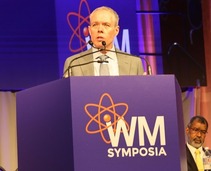 |
|
Read a story from last week's EM Update covering remarks by U.S. Deputy Energy Secretary David Turk and EM Senior Advisor William “Ike” White during the plenary session of the 2024 Waste Management Symposia.
|
  Dameone Ferguson, a management and program analyst serving as EM’s diversity manager, speaks during a panel titled, "DOE Minority Serving Institutions Partnership Program - Advancing a Sustainable, Diverse STEM Pipeline" at the 2024 Waste Management Symposia. The other panelists, from left, are Jadrien Huell, a computer engineering student at Claflin University, Ty Sanders, Idaho Cleanup Project site liaison, and Hardik Gohel, director of the Applied Artificial Intelligence Research Laboratory at the University of Houston-Victoria.
“The first thing is showing up,” Ty Sanders said as he and other members of a panel were asked for guidance about careers, mentorships and networking.
The senior advisor at EM’s Idaho National Laboratory Site said there are people who don’t want to fill out applications or sign up for events like the panel session they participated in at the 2024 Waste Management Symposia focusing on EM's Minority Serving Institutions Partnership Program (MSIPP) and advancing a sustainable, diverse science, technology, engineering and math (STEM) pipeline.
“Part of all this is just being there for each other and showing each other, ‘Hey, I have this type of thing going on. What can you help me with, what can I help you with,’” Sanders said. “And I encourage everyone here to take advantage of every single opportunity that’s available because once you go back from this week, you have probably less than 3,400 people all in one place. Take advantage of those resources while you’re here.”
His advice, tailored to the dozens of students in the audience, set the tone for a discussion in which a panel of two EM employees, a student and a university laboratory director shared advice with students looking to get ahead in STEM fields.
The EM MSIPP promotes the education and development of the next generation workforce in critical STEM related disciplines that complement current and future EM missions. EM recognizes that successfully completing its legacy environmental cleanup mission requires maintaining a highly-trained, technically skilled and diverse workforce. Minority representation in critical science and engineering fields is an important part of EM’s vision for this future workforce. EM MSIPP provides students and graduates of minority-serving institutions with hands-on education and experience by supporting collaborations between the institutions and DOE national laboratories.
Panelist Dameone Ferguson, a management and program analyst serving as EM’s diversity manager, expanded on insight from panelist Jadrien Huell, a computer engineering student at Claflin University, about a campus ecosystem supportive of college students that includes deans, professors and career advancement offices.
“I think that is a very vital ecosystem that you have access to within your own institution, and complementing that with the ecosystem that Energy brings, whether it’s environmental cleanup like where we’re having this focused conversation, or other facets of Energy,” Ferguson said. “The ability to be able to connect in with scientists, engineers and or HR professionals who may be able to help you get into a role and to help your career trajectory — all of those things complement one another when talking about ensuring the Jadriens and others that are represented in this room have access to opportunity.”
Jalesia Flowers-Steele, an Albany State University student pursuing a biology degree, was among the estimated 100 people in the audience at the panel session focused on EM’s Minority Serving Institutions Partnership Program (MSIPP) and advancing a sustainable, diverse STEM pipeline. Flowers-Steele works at a microbiology lab at the university and wants to go into biomedical engineering. She conducts experiments at the lab using samples from the Savannah River Site, funded by an EM MSIPP grant. “Your network is your net worth. That’s something they mentioned a lot throughout this particular panel. And I think I’ve heard the quote before but I didn’t realize how important it was in this field in particular. I’ve seen the real-life effects of having those kind of connections — by just reaching out to people and seeing what they have to offer, but also having something that you can offer to them. Mentorship is a two-sided relationship.” |
|
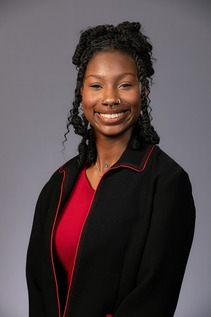 |
Asked by panel co-chair Genia McKinley, a general engineer with EM and program manager for the EM MSIPP, about maintaining a healthy student-life balance, Huell detailed how he works to get ahead of his assignments and pauses his commitments when necessary.
“That’s one thing I do to maintain that work-life balance,” Huell said. “Knowing when to take a break, to step back.”
He completed an internship at EM’s Savannah River National Laboratory (SRNL) last summer. Panel co-chair Vivian Holloway, the SRNL EM MSIPP program manager, said that Huell’s mentor specifically requested he return to the laboratory this summer, drawing applause from the audience.
Panelist Hardik Gohel, founding director of the Applied Artificial Intelligence Laboratory at the University of Houston-Victoria, discussed how he was born in India and studied in England before arriving in the United States.
“The United States has more resources for mentoring,” Gohel noted before encouraging students in the audience to get out and seek the many opportunities available to them. “I always make sure that my lab is growing, my students are growing, and the impact is exponential.”
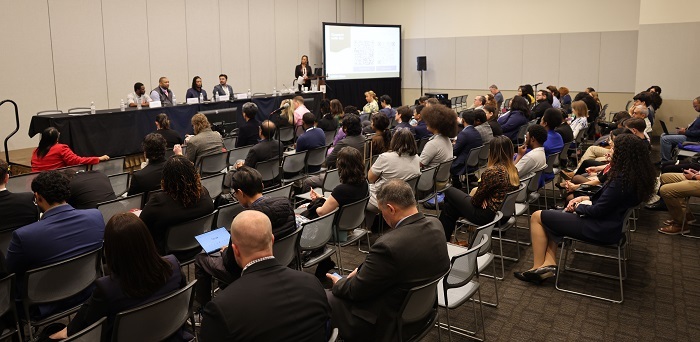 The panel session titled, "DOE Minority Serving Institutions Partnership Program - Advancing a Sustainable, Diverse STEM Pipeline" drew an audience of about 100 conference-goers at the 2024 Waste Management Symposia.
McKinley asked Ferguson how students can leverage EM’s workforce development resources to enhance their job readiness.
He emphasized that students and other potential employees have multiple entry points to the cleanup program, including the DOE Scholars Program and Pathways Recent Graduates Program. One challenge EM faces is transferring knowledge from existing and retiring employees, some of whom have been with the program for 20 years or more, to early career professionals.
“We have set up some really great services through the EM Workforce Management Office that help to augment some of that, whether it’s through our mentorship programs or executive speaker series, which becomes another organic way that we share information and sound bites — because we know 20 years of experience can get overwhelming in two months of time,” he said.
Sanders also urged the students to research the federal budget process, from the top-dollar number down to the fine print.
“We have to go advocate for the individuals around us, the stakeholders, the groups that are looking for us to support our communities,” he said. “If you can’t talk budget, then you are probably not going to go to a certain height in your career, you won’t be able to lift that ceiling.”
Sanders also encouraged the students to seek certifications from the Federal Emergency Management Agency Emergency Management Institute that teach them about leadership, resilience and responding to events such as a pandemic.
“Each week my mentees have an assignment and have to come back with a certificate. Certifications are huge. Don’t overlook those,” he advised.
A handful of students in the audience stepped up to the microphone to ask the panelists questions during the session. One of them asked about additional certifications available. Sanders, an experienced mentor, offered to follow up with detailed information.
“I think for me the mentoring piece for college students is critical. It’s crucial. It’s one of those things I wish I did more when I was in undergrad or a master’s program,” Sanders added.
-Contributors: Matt Roberts, David Sheeley
  From left, Atomic Energy of Canada Limited President and CEO Fred Dermarkar, EM Senior Advisor William "Ike" White and United Kingdom Nuclear Decommissioning Authority CEO David Peattie focused on challenges and opportunities and how they can collectively leverage their global expertise for the cleanup of nuclear legacy sites during a meeting on the margins of the 2024 Waste Management Symposia. (Photos: Matt Roberts)
PHOENIX — EM senior leaders William “Ike” White and Jeff Avery joined officials from the United Kingdom and Canada on the margins of this year’s 2024 Waste Management Symposia.
The Trilateral Standing Committee Meeting with the United Kingdom Nuclear Decommissioning Authority (NDA) and Atomic Energy of Canada Limited (AECL) provided the space for the officials from the respective countries to discuss challenges and opportunities and how they can collectively leverage their global expertise for the cleanup of nuclear legacy sites.
The three parties have made great progress since signing a trilateral agreement in 2020. The primary areas of collaboration include stakeholder engagement, sustainability, in situ decommissioning, aging infrastructure management and workforce development.
In July last year, EM participated in a stakeholder engagement workshop with U.K. and Canadian partners, featuring presentations, roundtables, case studies and opportunities for local and other government agencies, and interest groups to share successes and challenges related to stakeholder engagement.
Additionally, an in situ decommissioning workshop was held in Canada in December. The workshop included subject matter experts from EM, NDA and AECL, as well as state and federal regulators from the three countries.
The trilateral group, EM, NDA and AECL, collaborates on the successful decommissioning and remediation of legacy nuclear sites and the safe management of their radioactive waste to ensure the protection of present and future generations and the environment in their respective countries.
This year’s symposium drew the largest international attendance the conference has seen, boasting participants from 30 countries to commemorate it’s 50-year anniversary.
  Rodrigo Rimando, far right, acting director for the EM Office of Technology Development, introduces members of the panel titled, "A 50-Year DOE Retrospective and the Future of Environmental Remediation," as he kicks off the discussion as session co-chair. Also pictured, from left, Rodney Lehman, EM Office of Project Management director; Brian Vance, Hanford Site manager; Stanley Pyram, Savannah River Site chief engineer; Mark Brown, Idaho Cleanup Project manager; James Blankenhorn, senior vice president for Amentum; Inés Triay, interim dean, College of Engineering and Computing Applied Research Center, Florida International University; and Jean P. Pabón, program manager, EM Office of Technology Development.
Cleanup leaders reflect on past, discuss future challenges, opportunities
A perfect fit for this year’s Waste Management Symposia theme, “Proud of our Past, Poised for the Future,” this panel focused on the past 50 years of environmental remediation and engaged with the audience on challenges and opportunities as cleanup progress continues. Panelists provided historical overviews of EM’s Hanford, Idaho National Laboratory and Savannah River sites. They also cited some of the most significant successes while also highlighting critical lessons learned to be carried forward as EM continues to improve processes to best serve impacted communities. The collective knowledge of this panel made for a powerful discussion around future opportunities, with topics including incorporation of artificial intelligence to optimize infrastructure needs, increased use of clean energy alternatives to drive efficiencies and sustainability, and development of new technologies to tackle specific contaminants.
-Contributors: Kyle Hendrix, Matt Roberts
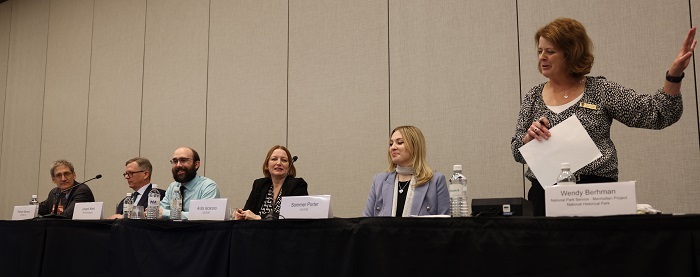 Wendy Berhman, superintendent of the Manhattan Project National Historical Park, speaks during a panel discussion on DOE’s Atomic Legacy Preservation Network. Also pictured from left are Josh Silverman, director, Office of Environmental Protection and Environment, Safety and Health Reporting; Padraic Benson, program analyst, DOE Office of Legacy Management; Joseph Kent, deputy director and curator, Atomic Museum; Anita Iacaruso, director of EM Communication Services; and Sommer Porter, public affairs specialist, EM Communication Services.
DOE's Atomic Legacy Preservation Network
EM is building the Atomic Legacy Preservation Network (ALPN), an interconnected network of institutions, linking the DOE Office of Legacy Management, National Nuclear Security Administration, museums, interpretive centers, national parks and other organizations to tell the story of EM’s history and progress.
“We’re casting a wide net and bringing together institutions that didn’t know that other ones like them exist,” EM Communication Services Director Anita Iacaruso said.
In April, EM will hold an introductory webinar hosted by the Institute of Museum and Library Services for institutions across the country to learn more about ALPN and how they can participate. Also in the works is an ALPN webpage as part of EM’s website.
-Contributors: Kim Kweder, Matt Roberts
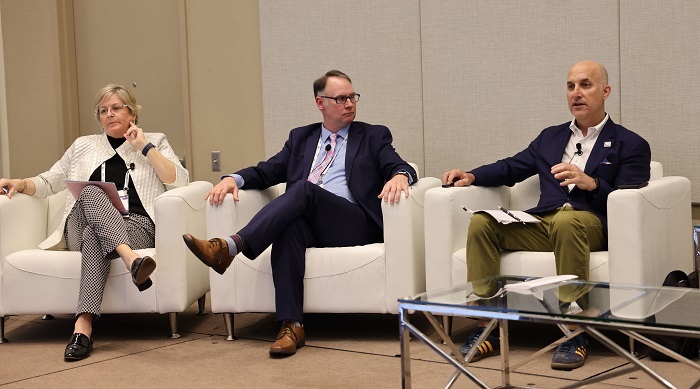 Panelist Rob Seifert, center, director of the EM Office of Infrastructure Management and Disposition Policy, panelist Seth Kirshenberg, at right, executive director, Energy Communities Alliance, and session co-chair Misty Mayes, CEO, Management Solutions, led a discussion at the 2024 Waste Management Symposia on the new DOE initiative "Cleanup to Clean Energy," an innovative effort to repurpose parts of DOE-owned lands for clean energy generation.
DOE highlights its Cleanup to Clean Energy initiative at conference
A new DOE initiative known as “Cleanup to Clean Energy” is working to repurpose parts of DOE-owned lands — portions of which were previously used in the nation’s nuclear weapons complex — for clean energy generation. Working with a diverse range of stakeholders, including industry, federal entities, tribes, and state and local officials, DOE will explore opportunities to lease federal land for the buildout of utility-scale clean energy projects. Panelists Rob Seifert, director of the EM Office of Infrastructure Management and Disposition Policy, and Seth Kirshenberg, executive director, Energy Communities Alliance, discussed the opportunities the initiative presents to specific locations during the 2024 Waste Management Symposia. Cleanup to Clean Energy is an innovative effort helping to achieve President Joe Biden’s climate goals and the directive in Executive Order 14057 for agencies to use their properties for the development of new clean electricity generation.
-Contributors: Eleanor Prater, Matt Roberts
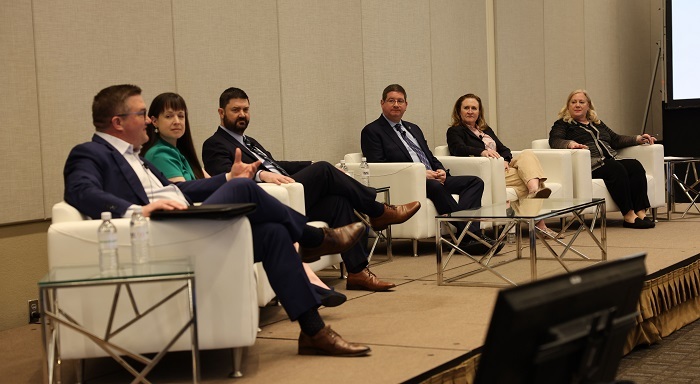 Pictured from left are panel session co-chair Martin Schneider, president, Longenecker & Associates; panelist Kristen Ellis, associate principal deputy assistant secretary for EM’s Office of Regulatory and Policy Affairs and EM acting director of regulatory, intergovernmental, and stakeholder engagement; panelist Jeff Avery, EM principal deputy assistant secretary; panelist Greg Sosson, associate principal deputy assistant secretary for EM's Office of Field Operations; panelist Angela Watmore, EM deputy assistance secretary for acquisition and project management; and panel session co-chair Dorothy Davidson, president and CEO, Orano Federal Services. (Photo: Matt Roberts)
EM leaders turn focus to EM’s hot topics at Waste Management
Members of the EM leadership team joined EM Principal Deputy Assistant Secretary Jeff Avery as panelists at the 2024 Waste Management Symposia to focus on hot topics within the cleanup program. There was standing room only for one of the first panels at this year’s conference, and the panelists highlighted EM priorities and focus areas for the coming years. Avery and members of the EM leadership team talked about various topics, from the importance of workforce staffing, to future missions, to the vital role technology development and deployment play within the EM program. Avery emphasized that EM needs to “continue making steady and deliberate progress” in coming years.
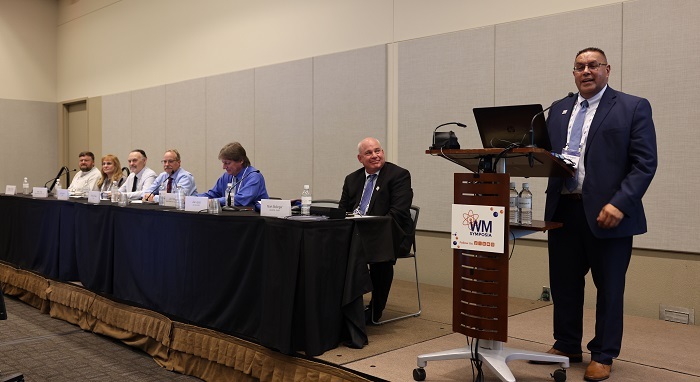 Carlsbad Field Office IT Division Director Joe Lopez speaks during a 2024 Waste Management Symposia panel session focused on the EM Waste Isolation Pilot Plant’s 25th anniversary. Also pictured from left are Gregory Roselle, senior manager, Defense Waste Management Programs, Sandia National Laboratories; Inés Triay, executive director, Applied Research Center, Florida International University; Jeff Stevens, executive officer, Newport News Nuclear BWXT Los Alamos; Thomas Peake, director, Center for Waste Management and Regulations, U.S. Environmental Protection Agency; Jack Volpato, chair, Mayor’s Nuclear Task Force of Carlsbad; and Mark Bollinger, manager, Carlsbad Field Office.
WIPP: Celebrating 25 years of cleanup history
As EM’s Waste Isolation Pilot Plant (WIPP) celebrates 25 years of operation, panelists shared personal stories of how they got their start there and how it changed the community for the better throughout the years.
“My WIPP journey has been memorable, and I would do it all over again,” said Joe Lopez, IT division director, Carlsbad Field Office, as he reflected on 39 years of WIPP service.
WIPP is the nation’s only geological repository for defense related nuclear waste. The site has around 1,500 federal and contractor employees. The first transuranic waste shipment arrived March 26, 1999.
The panel session also covered topics on the U.S. Environmental Protection Agency and its technical reviews at WIPP, accomplishments with shipments from Los Alamos National Laboratory, and WIPP’s construction journey.
-Contributors: Kim Kweder, Matt Roberts
 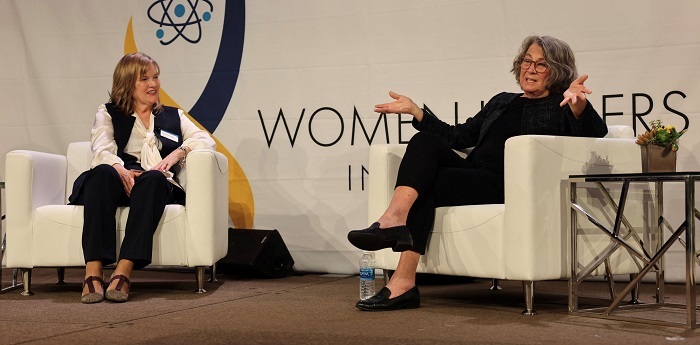 Patty McCord, right, shares stories and advice from her extensive leadership experience and professional journey with the audience at the highly attended Women Leaders in Nuclear Panel moderated by Katy Marshall, left. McCord is a workplace innovator, culture and leadership consultant and former chief talent officer at Netflix. Marshall is senior vice president, Operations, at Fluor.
PHOENIX, Ariz. — The Women Leaders in Nuclear Panel at the 2024 Waste Management Symposia last week took a different approach than previous years by featuring a keynote speaker from outside the nuclear industry.
Patty McCord, workplace innovator, culture and leadership consultant and former chief talent officer with Netflix served as the keynote speaker at the panel titled, “Embracing Change and Rethinking the Way We Lead.” The panel was moderated by Katy Marshall, senior vice president of Operations with Fluor.
The panel focused on advice for women on building their professional careers and establishing themselves as leaders.
 Kicking off the panel, McCord reflected on what she would tell her 24-year-old self.
“I wish I had known when I was young how good I was,” she said.
The validation that came with promotions and higher titles in her career helped grow confidence, but she emphasized the importance of knowing you’re great regardless of where you are in your career.
If McCord could go back, she would take more time to support other women during her career, she said. Returning to her first reflection, she wished she had reminded the younger women she worked with about how great they were as well.
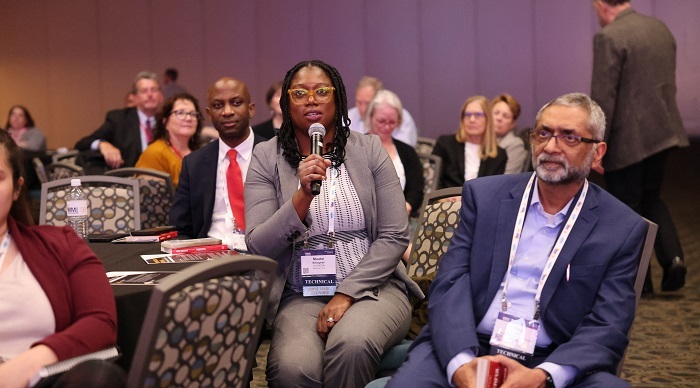 Audience member Maatsi Ndingwan with EM asks the Women Leaders in Nuclear Panel members a question.
Audience member Ashley Furman with Longenecker & Associates shared her biggest takeaway from the panel.
“The statement with the most impact for me was, ‘Know how good you are, even if you are young,'” she said. “It was a nice reminder that even though I am young, I am still valid in what I do know, and I should have confidence in that.”
A primary topic of the panel was how to be a good communicator, especially as a leader. McCord said the fundamentals of communication have not changed throughout her career.
“The very best way to learn to communicate is to learn to be honest and tell the truth,” she said, adding that communication is an art that needs to be practiced.
 EM Principal Deputy Assistant Secretary Jeff Avery, left, and EM Senior Advisor William "Ike" White listen to Patty McCord speak on leadership and communication during the Women Leaders in Nuclear Panel. McCord is a workplace innovator, culture and leadership consultant and former chief talent officer at Netflix.
The second most important part of communication is listening, according to McCord. She emphasized the importance of listening as an employee and leader. It’s a skill you have to learn, not only to understand the people you work with better, but to ensure that your words are being received in the way you intend.
“If you do great work and you listen, people will listen to you,” McCord said.
Addressing individuals in leadership roles in the audience, McCord noted that connecting with your employees and asking for their opinions is essential to building a great team. She shared her go-to questions to ask employees to help understand them better and fix issues that arise.
“If you were in management, what decision would you make?” she asked. “If you were in management, what information would you want to have to make the best decision?”
Asking her employees these questions has produced great success, bringing big issues to conclusion while understanding the employees’ way of thinking and learning.
-Contributors: Carly Howard, Matt Roberts
  EM Los Alamos Field Office (EM-LA) Manager Michael Mikolanis provides an update on the EM-LA strategic vision initiative and stakeholder participation, and outlines next steps for completing the vision on the remaining Los Alamos National Laboratory legacy cleanup projects.
PHOENIX — As EM continues to advance the legacy cleanup mission underway at Los Alamos National Laboratory (LANL), a key focus is instilling a strong culture of operational excellence and effective communication, EM and contractor representatives said here last week.
In a series of panels at this year’s Waste Management Symposia, leadership with the EM Los Alamos Field Office (EM-LA) and LANL legacy cleanup contractor Newport News Nuclear BWXT Los Alamos (N3B) highlighted the progress of the LANL legacy cleanup mission and planning for the future.
“Environmental remediation is a righteous mission,” N3B President and General Manager Brad Smith said. “Unless we do our work with excellence, we end up not only damaging the environment, but potentially ourselves, our families and our communities.”
New Technology Can Aid Waste Disposition
Smith outlined for Waste Management attendees the significant cleanup progress realized at LANL since 2018, including:
- Meeting 89 of 90 regulatory milestones as agreed to between EM-LA and the New Mexico Environment Department;
- Treating 424.5 million gallons of groundwater contaminated with hexavalent chromium, a known carcinogen, enough water to fill approximately 642 Olympic-sized pools;
- Completing cleanup at Middle DP Road Site, a project critical to Los Alamos County meeting its economic development needs;
- Completing 171 shipments of transuranic (TRU) waste to EM’s Waste Isolation Pilot Plant (WIPP); and
- Shipping more than 16,960 cubic meters of waste offsite from all waste streams, which is enough to fill more than 81,000 55-gallon drums or a football field more than 10 feet deep in waste.
EM-LA and N3B are examining the use of new technology that could further improve waste disposition efforts, Jeff Stevens, N3B acting executive officer, told the conference. A key step in waste disposition is performing an assay to ensure the waste is appropriately characterized as either TRU, requiring disposal at WIPP, or low-level waste, which can be disposed of at other licensed offsite facilities. The Universal Drum Assay and Segregation System, undergoing pilot project testing by N3B, has the potential to be more sensitive and accurate than the current assay approach of real-time radiography, according to Stevens.
“The volume [of disposal capacity] at WIPP is precious,” Stevens said. “Hopefully, this will work out well and be a great technology for the other sites.”
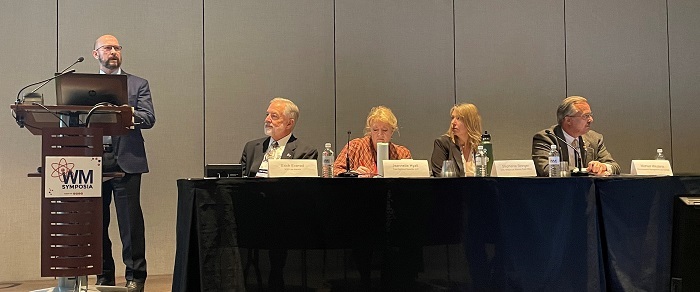 N3B President and General Manager Brad Smith shares how a workforce culture focused on safety helps support cleanup progress, and employee involvement in planning the work leads to increased ownership on the job.
Legacy Cleanup Workforce ‘In This Mission Together’
To ensure continued cleanup success today and in the future, N3B is working to instill a culture of disciplined and safe operations throughout its workforce, according to Smith. That has been especially important as new workers have joined the legacy cleanup mission without past nuclear related experience, he said.
Among the steps N3B has taken is an increased awareness of the role workforce culture plays in safely and successfully performing cleanup work, as well as increasing employee involvement in work planning and control so employees feel increased ownership in their activities, Smith said. He also noted that N3B has made a significant effort in improving its overall safety culture so workers feel comfortable in raising safety concerns, and stopping work if necessary, without fear of retaliation.
“I want my workforce to feel we’re in this mission together,” Smith said.
Also key to current and future cleanup success is effective communication, EM-LA Manager Michael Mikolanis said at the conference. That includes ensuring effective communication on various risks, as well as communicating to stakeholders the pros and cons of various cleanup approaches.
“The solution is safety, transparency, and respect, and balancing feedback with our regulator,” Mikolanis said.
Long Term Strategic Vision Halfway Through Development
Mikolanis also provided an update on EM-LA’s work to develop a long term strategic vision to guide the remaining legacy cleanup mission at LANL. This effort, led by N3B subcontractor Longenecker & Associates, has involved a multi-phase effort to solicit values and priorities from a wide array of engagement groups, including pueblos and stakeholders in Northern New Mexico, with more than 2,000 comments received, according to Mikolanis. Work is underway to analyze the feedback provided and develop guiding principles to shape the strategic vision, with public meetings planned to solicit additional feedback.
EM-LA currently anticipates completing the strategic vision by early 2025, Mikolanis said. While the vision is not yet finished, Mikolanis highlighted several successes already realized, including strengthening trust and relationships with pueblos and stakeholders, and increasing and enhancing knowledge of the LANL legacy cleanup mission.
“DOE wants to respect the people impacted by Los Alamos National Lab legacy waste,” Mikolanis said. “You can’t communicate enough to stakeholder groups.”
-Contributors: Mike Nartker, Todd Nelson
 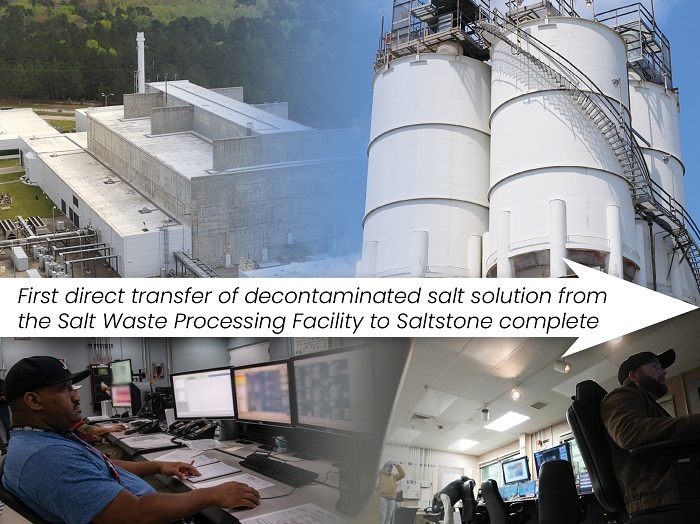 Savannah River Mission Completion successfully made the first transfer of decontaminated salt solution directly from one waste processing facility to another, bypassing a hold tank previously used in the transfer process.
AIKEN, S.C. — EM’s liquid waste contractor at the Savannah River Site (SRS) this month marked the first direct transfer of decontaminated waste from the Salt Waste Processing Facility (SWPF) to the Saltstone Production Facility (SPF), an important new step in optimizing waste processing.
Savannah River Mission Completion (SRMC) streamlined the inter-area waste transfers by directly routing them from one waste processing facility to another, bypassing a holding tank in H Tank Farm, one of two groupings of underground waste tanks at SRS.
SWPF separates and concentrates the highly radioactive waste components found in the SRS Tank Farms — such as uranium, plutonium and cesium — from the less radioactive salt solution.
The concentrated high-activity waste from SWPF is sent to the Defense Waste Processing Facility to be vitrified into a solid glass form suitable for long term storage and disposal. The decontaminated salt solution (DSS) from SWPF is sent to SPF where it is mixed with dry materials to create a grout, which is then poured into Saltstone Disposal Units to harden into a form safe for permanent onsite disposal.
Previously, the DSS from SWPF was transferred first to Tank 50 before proceeding to SPF for final treatment and disposal. At 1.3 million gallons, Tank 50 is one of the site’s larger tanks with the capacity to hold the throughput of material temporarily when SPF is not processing.
Tank 50 was initially needed since SPF operated only four days week, and SWPF is a 24/7 facility. Without a hold tank between the two areas, transfers would become backlogged throughout the liquid waste system. SPF has now transitioned to 24/7 operations to support the increased production rate of DSS from SWPF.
SWPF was originally designed to transfer DSS directly to SPF, so no physical modifications were required on transfer lines. Programming and procedural changes were made to make the direct transfers possible. SRMC will maintain the capability to use Tank 50 as a hold tank if needed during times when SPF cannot accept DSS, such as facility outages.
Rerouting waste on a direct path between processing facilities simplifies the transfer process and minimizes operational impacts on the liquid waste system, according to Jim Folk, DOE-Savannah River assistant manager for waste disposition.
“EM’s tank waste cleanup mission is moving forward faster and more efficiently now that all liquid waste facilities are operating 24/7,” Folk said. “These facilities work as an integrated system, so it is crucial that management and personnel communicate and coordinate activities to ensure all operations, especially waste transfers between areas, are completed safely and effectively.”
The option to send waste transfers directly from SWPF to SPF adds a tremendous amount of flexibility to operations, according to Wyatt Clark, SRMC chief operations officer.
“One of SRMC’s primary goals and core values is reliability,” Clark said. “Optimizing waste transfers is just another example that we are ensuring that our systems are robust, reliable and well equipped to complete the mission for the Department of Energy. Furthermore, this approach reduces the number of transfers between SWPF, Tank 50 and SPF by 50%, which is a significant benefit that resulted from the consolidation of Effluent Treatment Facility and SPF staffing.”
-Contributor: Colleen Hart
  Tours of the EM Hanford Site’s B Reactor National Historic Landmark are resuming this month for a limited time. B Reactor is part of the Manhattan Project National Historical Park and is operated by the Department of Energy.
RICHLAND, Wash. — Public tours are set to resume this month for a limited time at the Hanford Site’s B Reactor National Historical Park, part of the Manhattan Project National Historical Park, which also includes facilities in Los Alamos, New Mexico, and Oak Ridge, Tennessee.
Last August, EM announced that planned historic preservation work at B Reactor would require closure of the facility for at least two tour seasons after the 2023 season ended in November. Hanford contractor Central Plateau Cleanup Company is set to carry out the preservation work. As the company’s plans and schedules came together, DOE identified an opportunity to allow additional public access before the preservation work begins.
“Last summer’s announcement, combined with the popularity of the movie ‘Oppenheimer,’ led to all seats for the remainder of the 2023 tour season being booked within two days as people rushed to reserve the remaining seats through mid-November,” said Colleen French, DOE’s national park program manager. “I’m so happy we’re able to give people another chance to get out there and see this amazing piece of history for themselves before the work gets going.”
Tour seats are available March 29 through the end of June, and then will be opened on a month-by-month basis from July to September, depending on the contractor’s construction schedule. Visitors of all ages and nationalities are welcome. To register for a tour or for more information, visit the tour website.
Since B Reactor tours began in 2009, visitors have come from all 50 states and more than 90 countries around the world. The tours also have a positive economic effect on the surrounding communities, bringing several million dollars each year in hotel bookings, restaurant visits and purchases.
The free tours last about four hours and offer a guided experience and time for visitors to walk around on their own to ask questions and reflect on the complicated legacy of the Manhattan Project and its continued impact worldwide.
Can’t make it in person? The Manhattan Project National Historical Park has virtual tours for B Reactor, Hanford’s T Plant and Oak Ridge’s X-10 Graphite Reactor and Y-12 Pilot Plant.
 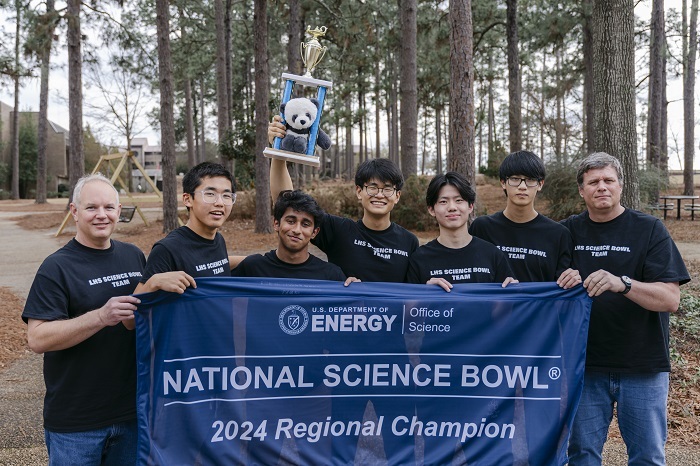 This year's winners, Lakeside High School Team 1 from Evans, Georgia, earned an all-expense paid trip to DOE's National Science Bowl in Washington, D.C., April 25-29. Pictured from left are coach John Cato, Jerry Fan, Iziq Thomas, Jerry Lu, George Zhou, David Wang and coach David Arrington.
Challenging America’s brightest in one of the most prestigious academic science competitions
AIKEN, S.C. — Future scientists, engineers and mathematicians recently put their knowledge to the test during the annual DOE Savannah River Regional Science Bowl Competition, which attracted nine teams from South Carolina and the greater Augusta, Georgia, area.
Lakeside High School Team 1 of Evans, Georgia, won an all-expense paid trip to DOE’s National Science Bowl in Washington, D.C., set for April 25-29. Lakeside High School Team 2 placed second and Dorman High School placed third.
“Students arrived feeling excited and ready to show off their brilliant skills,” said Cindy Hewitt, Education Outreach specialist for EM contractor Savannah River Nuclear Solutions. “Competing teams work incredibly hard studying, practicing and strategizing each year to win this regional competition and continue on to D.C.”
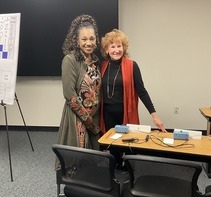 |
|
Read a related EM Update story on how the Savannah River Site and EM's Waste Isolation Pilot Plant recently collaborated to bring the DOE Regional Science Bowl to Southeast New Mexico.
|
Teams faced off in a fast-paced question-and-answer format like the television show “Jeopardy.” Questions cover a range of academic disciplines including biology, chemistry, Earth science, physics, energy and math.
“It’s inspiring to witness the level of intelligence that is displayed in each round of the competition,” Hewitt remarked. “It is the ultimate test of the students’ ability to perform well under pressure.”
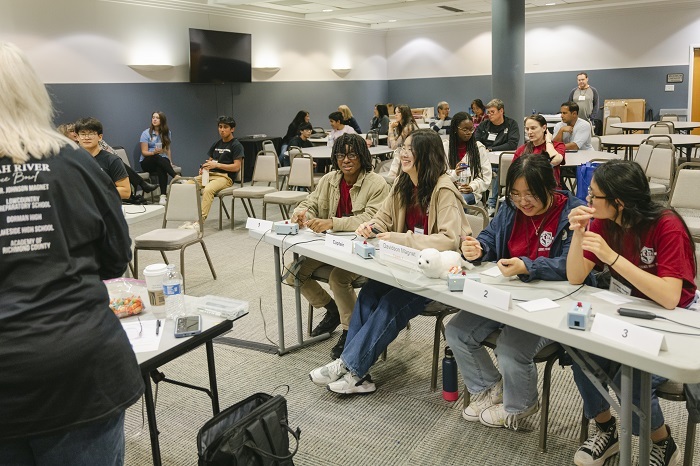 Davidson Fine Arts Magnet School team members Amari Robinson, Caroline Moon, Elizabeth Xie and Hanyu Zhou test their buzzers before a round. Teammate Adetutu Adeyemi and coach Jillian Harold are pictured sitting behind the table.
Each team consists of five students and a teacher who serves as coach. After winning the 2023 regional competition, coaches David Arrington and John Cato from Lakeside High School said their teams were thrilled for the chance to protect their winning title.
“Our students are proud to blaze a trail for others interested in science, engineering and math,” said Arrington. “This team has grown and evolved since middle school and enjoys every minute of competing together and showing what they are capable of.”
Cato said the competition teaches students how to make mistakes and bounce back by rallying together.
“As we gear up for nationals, I hope my team can look back on this experience and see the friendship and support they’ve gained from the extra hours and effort put into this program,” he said.
Savannah River Site (SRS) has participated annually at the regional level since DOE created the National Science Bowl in 1991. This year’s SRS-sponsored regional contest involved 64 students from nine high schools and is the only academic competition of its kind.
“Our performance was a testimony of the work we’ve put in all year to build our team from scratch,” said Amari Robinson, an 11th grade student from Davidson Fine Arts Magnet School. “We went from practicing in a controlled and calm environment to a high-pressure competition that required us to ‘buzz in’ within seconds. It was the most nerve-wracking and rewarding experience.”
 Savannah River Mission Completion Engineering Recruiter Connie Yung, right, shares the rules of the competition before a match.
Volunteers from multiple SRS contractors work as judges, scorekeepers, moderators and timekeepers during the regional tournament each year.
“For over 10 years, I’ve volunteered and supported this competition as a moderator,” said Connie Yung, engineering recruiter for EM liquid waste contractor Savannah River Mission Completion. “I hope I can inspire at least one student here to pursue a career in STEM just like they inspire me with their energy and intensity. Witnessing students less than half my age answer some of these difficult questions is what brings me back, year after year.”
To reach the National Science Bowl, teams from across the United States must win one of 65 regional tournaments. Approximately 344,000 students have squared off in the National Science Bowl finals.
The primary goals of SRS outreach programs are to enhance students’ interest in science, technology, engineering and math. These programs use unique site resources to support improvements in Central Savannah River Area education.
Click the blue box below for more information about the DOE Savannah River Regional Science Bowl.
-Contributor: Mackenzie McNabb
|